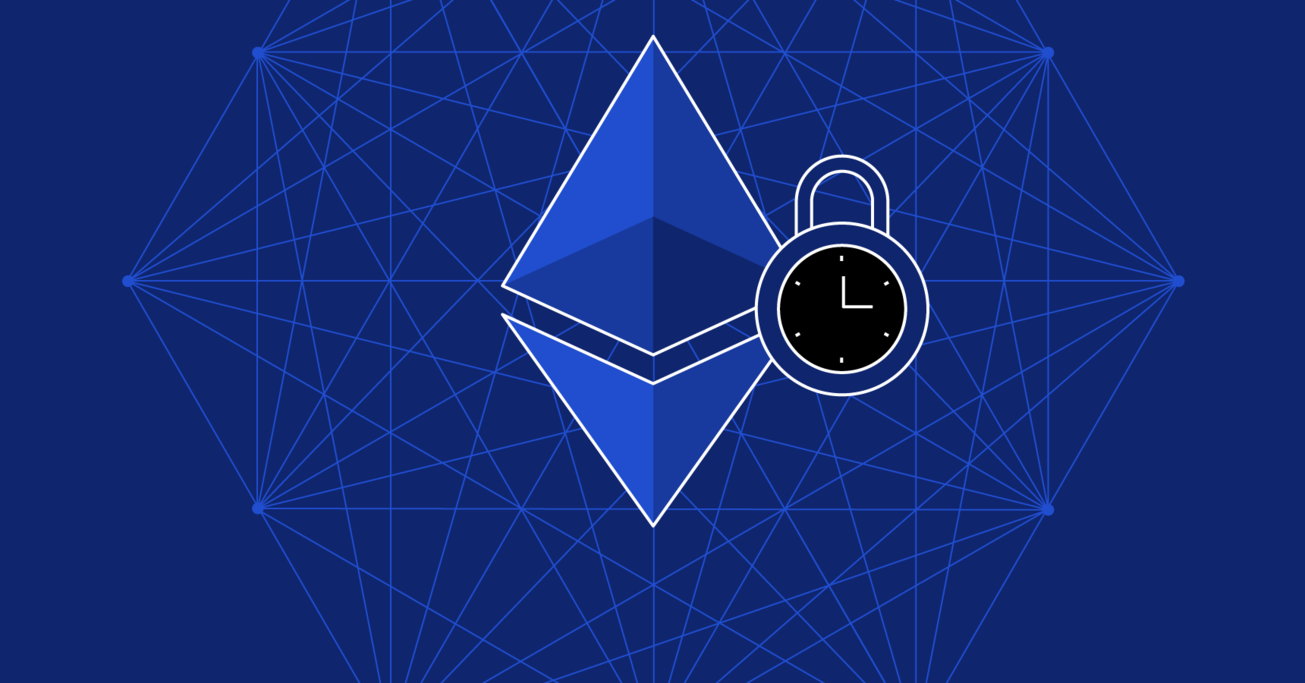Time-locked Wallets: An Introduction to Ethereum Smart Contracts
Launch yourself into Ethereum smart contract development with the Truffle framework! In this tutorial, Toptal Freelance Ethereum Developer Radek Ostrowski shows you how to create a practical ĐApp in the Solidity language, complete with its own ERC20 token.
Launch yourself into Ethereum smart contract development with the Truffle framework! In this tutorial, Toptal Freelance Ethereum Developer Radek Ostrowski shows you how to create a practical ĐApp in the Solidity language, complete with its own ERC20 token.
Radek is a blockchain engineer with an interest in Ethereum smart contracts. He also has extensive experience in machine learning.
PREVIOUSLY AT

Blockchain and its applications are popular nowadays as never before. Ethereum in particular, offering smart contract capabilities, opens the doors to new ideas that can be implemented in a distributed, immutable, and trustless fashion.
Getting started in the Ethereum smart contract space can be a little overwhelming as the learning curve is quite steep. We hope that this article (and future articles in the Ethereum series) can alleviate this pain and get you up and running quickly.
Truffle, Solidity, and ĐApps
In this article, we assume you have some basic understanding of blockchain applications and Ethereum. If you feel like you need to brush up your knowledge, we recommend this Ethereum overview from the Truffle framework.
What’s covered in this post:
- Applications of time-locked wallets
- Development environment setup
- Smart contract development with the Truffle framework
- Description of Solidity contracts
- How to compile, migrate, and test smart contracts
- Using a ÐApp to interact with smart contracts from the browser
- Browser setup with MetaMask
- A run-through of the main use case
Time-locked Wallets: Use Cases
There are many different applications of Ethereum smart contracts. The most popular at the moment are cryptocurrencies (implemented as ERC20 tokens) and crowdfunding token sales (a.k.a. initial coin offerings, or ICOs.) A good example of a utility ERC20 token is the Motoro Coin. In this blog post, we will explore something different: The idea of locking funds in crypto wallet contracts. This idea itself has various use cases.
Vesting for an ICO
There are several examples, but probably the most common reason at the moment to lock funds is called “vesting.” Imagine that you have just raised a successful ICO and your company still holds a majority of tokens distributed between your team members.
It would be beneficial to all parties involved to ensure that the tokens held by employees cannot be traded straightaway. If there are no controls in place, any given employee might take action by selling all their tokens, cashing out, and quitting the company. This would negatively affect the market price and make all remaining contributors to the project unhappy.
Crypto-based “Last Will and Testament”
Another idea is to use a smart contract as a crypto-will. Imagine we would like to store our cryptocurrency savings in a contract which will be accessible by members of the family, but only after something has happened to us. Let’s say we should “check in” with the wallet, by evoking some contract call every so-often.
If we don’t check in on time, something presumably happened to us and they can withdraw the funds. The proportion of funds they would each receive could either be explicitly set in the contract, or it could be left to be decided by consensus among the family members.
A Pension or Trust Fund
Another application of locking funds could be to create a small pension fund or time-based savings account, i.e., one that prevents the owner from withdrawing any funds before a certain time in the future. (It could be particularly useful for addicted crypto traders in helping keep their ether intact.)
The use case we’ll explore for the rest of this blog post is similar: To put some crypto-money away for later for someone else, like a future birthday gift.
Let’s imagine we would like to gift one ether to someone for their 18th birthday. We could write down on a piece of paper the account’s private key and the address of the wallet holding the funds and hand it over to them in an envelope. The only thing they would have to do is call a function on the contract from their account once they are 18 and all the funds will be transferred to them. Or, instead, we could just use a simple ÐApp. Sounds good? Let’s get started!
Ethereum Development Setup
Before you forge ahead with smart contract development, you need to have Node.js and Git installed on your machine. In this blog, we are going to be using the Truffle framework. Even though you can do without it, Truffle significantly reduces the entry barrier to the development, testing, and deployment of Ethereum smart contracts. We totally agree with their statement:
Truffle is the most popular development framework for Ethereum with a mission to make your life a whole lot easier.
To install it, run the following command:
npm install -g truffle
Now, get the code of this project:
git clone https://github.com/radek1st/time-locked-wallets
cd time-locked-wallets
It is important to note that the project follows the standard Truffle project structure and the directories of interest are:
-
contracts: Holds all the Solidity contracts -
migrations: Contains scripts describing the steps of migration -
src: Includes the ÐApp code -
test: Stores all the contract tests
Overview of the Included Smart Contracts
There are several contracts included in this project. Here’s the rundown:
-
TimeLockedWallet.solis the main contract of this project and it is described in detail below. -
TimeLockedWalletFactory.solis thefactorycontract which lets anyone easily deploy their ownTimeLockedWallet. -
ERC20.solis an interface of the ERC20 standard for Ethereum tokens. -
ToptalToken.solis a customized ERC20 token. -
SafeMath.solis a small library used by ToptalToken for performing safe arithmetic operations. -
Migrations.solis an internal Truffle contract facilitating migrations.
For any questions on writing Ethereum contracts, please refer to the official Solidity smart contract docs.
TimeLockedWallet.sol
Our TimeLockedWallet.sol Solidity contract looks like this:
pragma solidity ^0.4.18;
The above line indicates the minimum version of the Solidity compiler required for this contract.
import "./ERC20.sol";
Here, we import other contract definitions, used later in the code.
contract TimeLockedWallet {
...
}
The above is our main object. contract scopes the code of our contract. The code described below is from inside the curly brackets.
address public creator;
address public owner;
uint public unlockDate;
uint public createdAt;
Here we define several public variables which by default generate corresponding getter methods. A couple of them are of type uint (unsigned integers) and a couple are address (16-character long Ethereum addresses.)
modifier onlyOwner {
require(msg.sender == owner);
_;
}
In simple terms, modifier is a precondition that has to be met before even starting the execution of the function it is attached to.
function TimeLockedWallet(
address _creator, address _owner, uint _unlockDate
) public {
creator = _creator;
owner = _owner;
unlockDate = _unlockDate;
createdAt = now;
}
This is our first function. As the name is exactly the same as our contract name, it is the constructor and gets called only once when the contract is created.
Note that if you were to change the name of the contract, this would become a normal function callable by anyone and form a backdoor in your contract like was the case in the Parity Multisig Wallet bug. Additionally, note that the case matters too, so if this function name were in lowercase it would also become a regular function—again, not something you want here.
function() payable public {
Received(msg.sender, msg.value);
}
The above function is of a special type and is called the fallback function. If someone sends any ETH to this contract, we will happily receive it. The contract’s ETH balance will increase and it will trigger a Received event. To enable any other functions to accept incoming ETH, you can mark them with the payable keyword.
function info() public view returns(address, address, uint, uint, uint) {
return (creator, owner, unlockDate, createdAt, this.balance);
}
This is our first regular function. It has no function parameters and defines the output tuple to be returned. Note that this.balance returns the current ether balance of this contract.
function withdraw() onlyOwner public {
require(now >= unlockDate);
msg.sender.transfer(this.balance);
Withdrew(msg.sender, this.balance);
}
The above function can only be executed if onlyOwner modifier defined earlier is satisfied. If the require statement is not true, the contract exits with an error. That’s where we check if the unlockDate has gone by. msg.sender is the caller of this function and it gets transferred the entire ether balance of the contract. In the last line, we also fire a Withdrew event. Events are described a bit later.
Interestingly, now—which is equivalent to block.timestamp—may not be as accurate as one may think. It is up to the miner to pick it, so it could be up to 15 minutes (900 seconds) off as explained in the following formula:
parent.timestamp >= block.timestamp <= now + 900 seconds
As a consequence, now shouldn’t be used for measuring small time units.
function withdrawTokens(address _tokenContract) onlyOwner public {
require(now >= unlockDate);
ERC20 token = ERC20(_tokenContract);
uint tokenBalance = token.balanceOf(this);
token.transfer(owner, tokenBalance);
WithdrewTokens(_tokenContract, msg.sender, tokenBalance);
}
Here is our function for withdrawing ERC20 tokens. As the contract itself is unaware of any tokens assigned to this address, we must pass in the address of the deployed ERC20 token we want to withdraw. We instantiate it with ERC20(_tokenContract) and then find and transfer the entire token balance to the recipient. We also fire a WithdrewTokens event.
event Received(address _from, uint _amount);
event Withdrew(address _to, uint _amount);
event WithdrewTokens(address _tokenContract, address _to, uint _amount);
In this snippet, we are defining several events. Triggered events are basically log entries attached to the transaction receipts on the blockchain. Each transaction can attach zero or more log entries. The main uses of events are debugging and monitoring.
That’s all we need to time-lock ether and ERC20 tokens—just a few lines of code. Not too bad, huh? Now let’s have a look at our other contract, TimeLockedWalletFactory.sol.
TimeLockedWalletFactory.sol
There are two main reasons behind creating a higher-level factory contract. The first one is a security concern. By separating the funds in different wallets, we won’t end up with just one contract with a massive amount of ether and tokens. This will give 100% of control to just the wallet owner and hopefully discourage the hackers from trying to exploit it.
Secondly, a factory contract allows easy and effortless TimeLockedWallet contract creation, without the requirement of having any development setup present. All you need to do is to call a function from another wallet or ĐApp.
pragma solidity ^0.4.18;
import "./TimeLockedWallet.sol";
contract TimeLockedWalletFactory {
...
}
The above is straightforward and very similar to the previous contract.
mapping(address => address[]) wallets;
Here, we define a mapping type, which is like a dictionary or a map, but with all the possible keys preset and pointing to default values. In the case of the address type, the default is a zero address 0x00. We also have an array type, address[], which is holding addresses.
In the Solidity language, Arrays always contain one type and can have a fixed or variable length. In our case, the array is unbounded.
To sum up our business logic here, we define a mapping called wallets which consists of user addresses—contract creators and owners alike—each pointing to an array of associated wallet contract addresses.
function getWallets(address _user)
public
view
returns(address[])
{
return wallets[_user];
}
Here, we are using the above function to return all contract wallets a _user created or has rights to. Note that view (in older complier versions called constant) denotes that this is a function that doesn’t change the blockchain state and can be therefore called for free, without spending any gas.
function newTimeLockedWallet(address _owner, uint _unlockDate)
payable
public
returns(address wallet)
{
wallet = new TimeLockedWallet(msg.sender, _owner, _unlockDate);
wallets[msg.sender].push(wallet);
if(msg.sender != _owner){
wallets[_owner].push(wallet);
}
wallet.transfer(msg.value);
Created(wallet, msg.sender, _owner, now, _unlockDate, msg.value);
}
This is the most important part of the contract: The factory method. It lets us create a new time-locked wallet on the fly, by calling its constructor: new TimeLockedWallet(msg.sender, _owner, _unlockDate). We then store its address for the creator and the recipient. Later we transfer all the optional ether passed in this function execution to the newly created wallet address. Finally, we signal the Create event, defined as:
event Created(address wallet, address from, address to, uint createdAt, uint unlockDate, uint amount);
ToptalToken.sol
This tutorial wouldn’t be so much fun if we didn’t create our own Ethereum token, so for completeness, we are bringing to life ToptalToken. ToptalToken is a standard ERC20 token implementing the interface presented below:
contract ERC20 {
uint256 public totalSupply;
function balanceOf(address who) public view returns (uint256);
function transfer(address to, uint256 value) public returns (bool);
function allowance(address owner, address spender) public view returns (uint256);
function transferFrom(address from, address to, uint256 value) public returns (bool);
function approve(address spender, uint256 value) public returns (bool);
event Approval(address indexed owner, address indexed spender, uint256 value);
event Transfer(address indexed from, address indexed to, uint256 value);
}
What distinguishes it from other tokens is defined below:
string public constant name = "Toptal Token";
string public constant symbol = "TTT";
uint256 public constant decimals = 6;
totalSupply = 1000000 * (10 ** decimals);
We gave it a name, a symbol, total supply of one million, and made it divisible up to six decimals.
To discover different variations of token contracts, feel free to explore the OpenZeppelin repo.
Truffle Console: Compile, Migrate, and Test Smart Contracts
To get started quickly, run Truffle with the built-in blockchain:
truffle develop
You should see something like this:
Truffle Develop started at http://localhost:9545/
Accounts:
(0) 0x627306090abab3a6e1400e9345bc60c78a8bef57
(1) 0xf17f52151ebef6c7334fad080c5704d77216b732
(2) 0xc5fdf4076b8f3a5357c5e395ab970b5b54098fef
(3) 0x821aea9a577a9b44299b9c15c88cf3087f3b5544
(4) 0x0d1d4e623d10f9fba5db95830f7d3839406c6af2
(5) 0x2932b7a2355d6fecc4b5c0b6bd44cc31df247a2e
(6) 0x2191ef87e392377ec08e7c08eb105ef5448eced5
(7) 0x0f4f2ac550a1b4e2280d04c21cea7ebd822934b5
(8) 0x6330a553fc93768f612722bb8c2ec78ac90b3bbc
(9) 0x5aeda56215b167893e80b4fe645ba6d5bab767de
Mnemonic: candy maple cake sugar pudding cream honey rich smooth crumble sweet treat
The mnemonic seed lets you recreate your private and public keys. For example, import it into MetaMask as shown here:
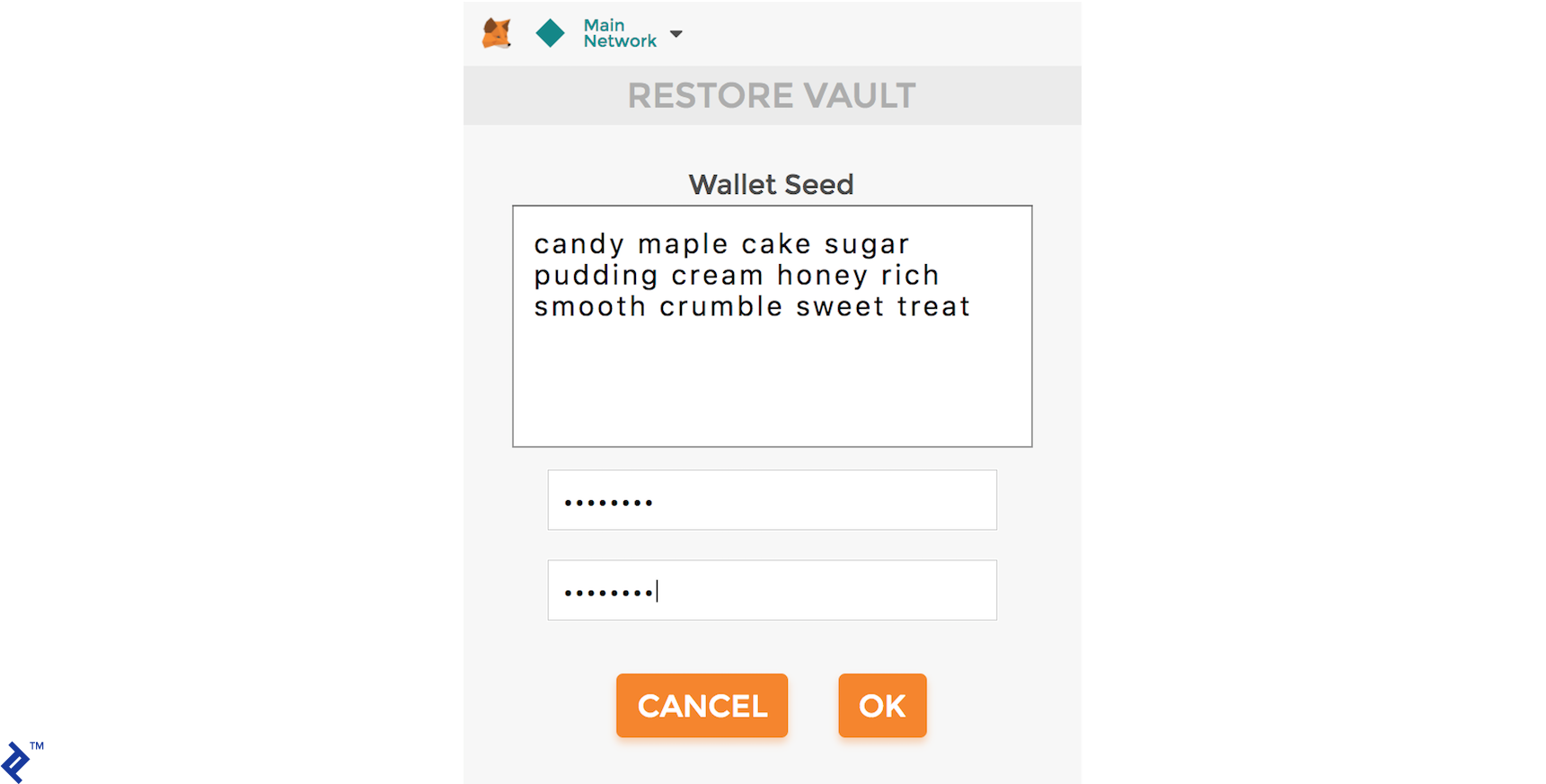
To compile the contracts, run:
> compile
You should see:
Compiling ./contracts/ERC20.sol...
Compiling ./contracts/Migrations.sol...
Compiling ./contracts/SafeMath.sol...
Compiling ./contracts/TimeLockedWallet.sol...
Compiling ./contracts/TimeLockedWalletFactory.sol...
Compiling ./contracts/ToptalToken.sol...
Writing artifacts to ./build/contracts
Now, we need to define which contracts we want to have deployed. This is done in migrations/2_deploy_contracts.js:
var TimeLockedWalletFactory = artifacts.require("TimeLockedWalletFactory");
var ToptalToken = artifacts.require("ToptalToken");
module.exports = function(deployer) {
deployer.deploy(TimeLockedWalletFactory);
deployer.deploy(ToptalToken);
};
We first import our two contract artifacts TimeLockedWalletFactory and ToptalToken. Then we simply deploy them. We missed TimeLockedWallet on purpose, as this contract is deployed dynamically. For more information on migrations, please refer to the Truffle migrations documentation.
To migrate the contracts, run:
> migrate
This should result in something resembling the following:
Running migration: 1_initial_migration.js
Deploying Migrations...
... 0x1c55ae0eb870ac1baae86eeb15f3aba3f521df46d9816e04400e9b5951ecc099
Migrations: 0x8cdaf0cd259887258bc13a92c0a6da92698644c0
Saving successful migration to network...
... 0xd7bc86d31bee32fa3988f1c1eabce403a1b5d570340a3a9cdba53a472ee8c956
Saving artifacts...
Running migration: 2_deploy_contracts.js
Deploying TimeLockedWalletFactory...
... 0xe9d9c37508bb58a1591d0f052d6870810118a0a19f728bf0cea4f4e5c17acd7a
TimeLockedWalletFactory: 0x345ca3e014aaf5dca488057592ee47305d9b3e10
Deploying ToptalToken...
... 0x0469ce110735f27bbb1a85c85a77ba4b0ba0d5aa52c3d67164045b849d8b2ed6
ToptalToken: 0xf25186b5081ff5ce73482ad761db0eb0d25abfbf
Saving successful migration to network...
... 0x059cf1bbc372b9348ce487de910358801bbbd1c89182853439bec0afaee6c7db
Saving artifacts...
You can tell that TimeLockedWalletFactory and ToptalToken got deployed successfully.
Finally, to ensure all is working well, let’s run some tests. The tests are located in the test directory and correspond to the main contracts TimeLockedWalletTest.js and TimeLockedWalletFactoryTest.js. For brevity, we’ll not go into the details of writing tests, and leave it as an exercise for the reader. To execute the tests, simply run:
> test
…and hopefully you’ll see all the tests passing like this:
Contract: TimeLockedWalletFactory
✓ Factory created contract is working well (365ms)
Contract: TimeLockedWallet
✓ Owner can withdraw the funds after the unlock date (668ms)
✓ Nobody can withdraw the funds before the unlock date (765ms)
✓ Nobody other than the owner can withdraw funds after the unlock date (756ms)
✓ Owner can withdraw the ToptalToken after the unlock date (671ms)
✓ Allow getting info about the wallet (362ms)
6 passing (4s)
Time-Locked Wallet ÐApp
It’s time to see it all in action. The easiest way to interact with any blockchain is by using distributed applications with a web UI, so called ÐApps (or sometimes “dapps.”)
Distributed Application Setup
In order to run this ÐApp, you will need to have an Ethereum-enabled browser. The easiest way of achieving this is to install the MetaMask Chrome plugin. There’s also a visual guide on installing and configuring MetaMask with Truffle.
Smart Contract Scenario
Coming back to our scenario, why don’t we introduce the actors first? Let’s assume Alice is going to be the creator of the time-locked wallet and Bob will be the recipient/eventual owner of the funds.
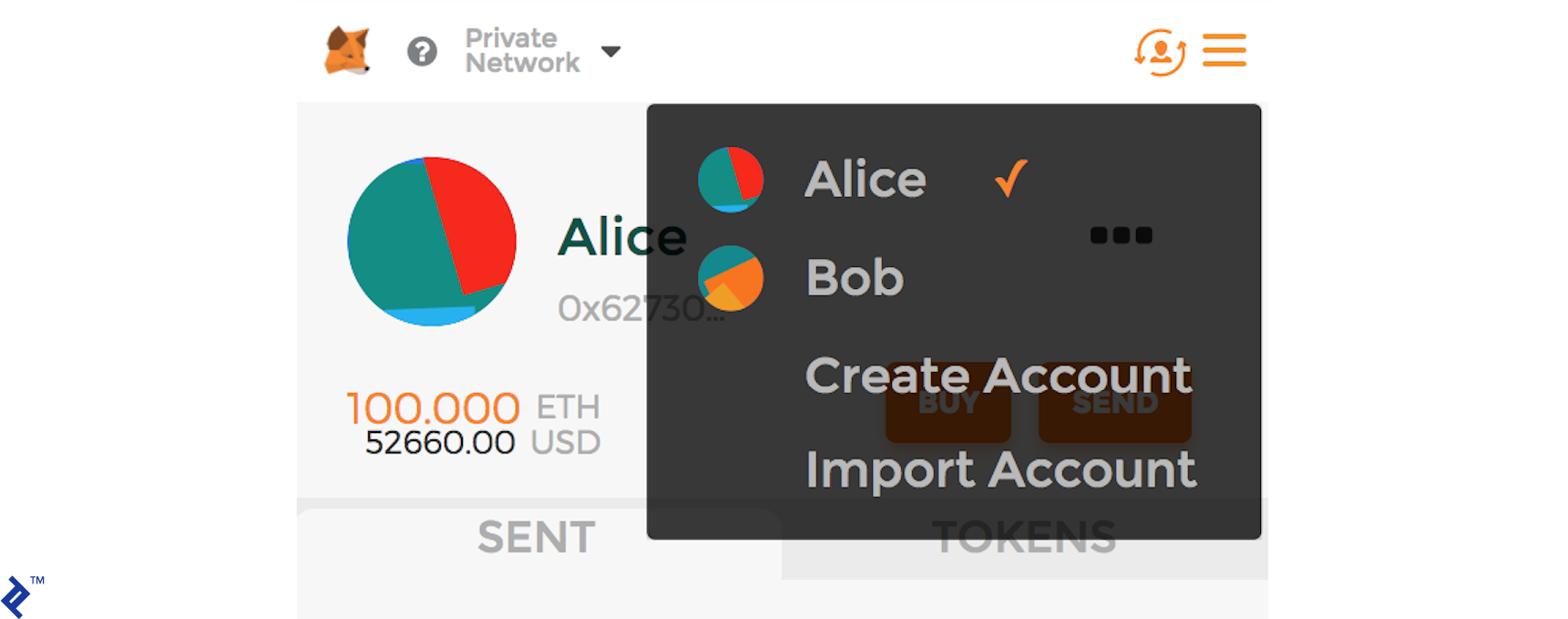
Scenario Outline:
- Alice creates a time-locked wallet for Bob and sends some ETH
- Alice additionally sends some ERC20 Toptal Tokens
- Bob can see the wallets he has access to and the ones he created
- Bob cannot withdraw any funds before the wallet’s time lock expires
- Bob withdraws the ETH when it gets unlocked
- Bob withdraws all ERC20 Toptal Tokens
Firstly, Alice creates a time-locked wallet for Bob and sends an initial one ether. We can see that a new contract wallet has been created and is owned by Bob:
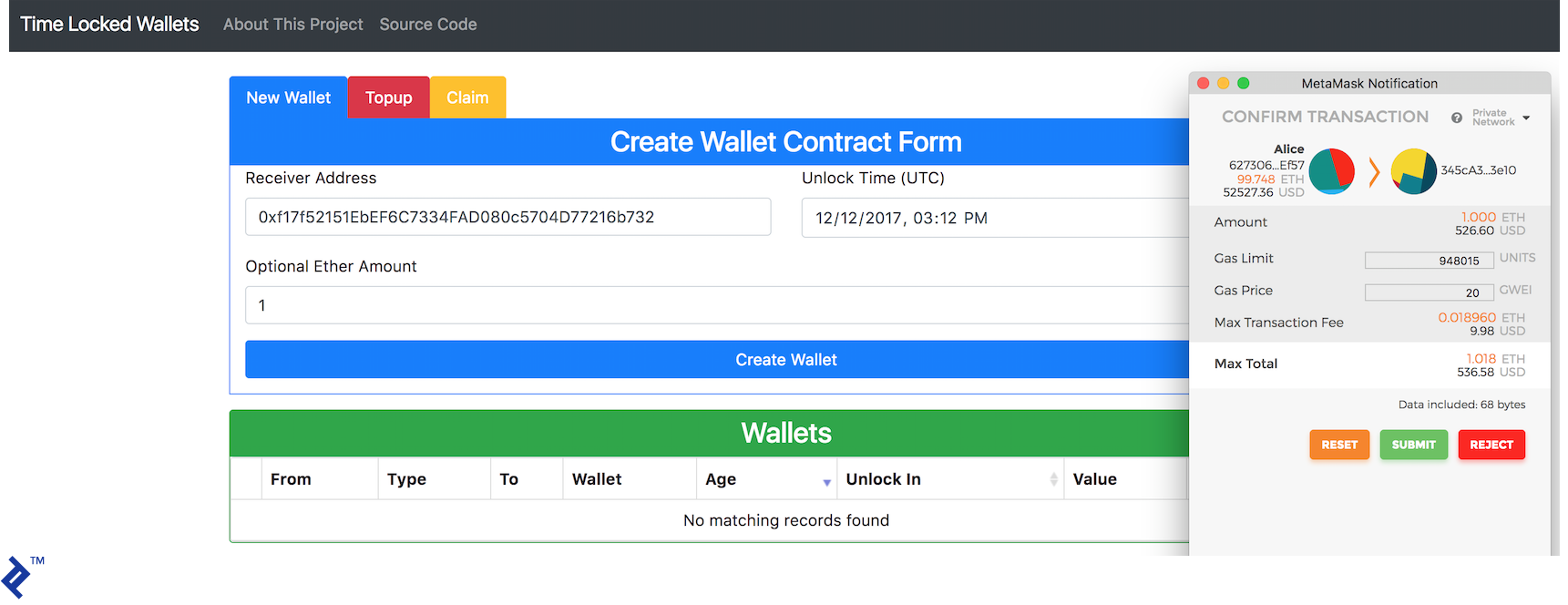
At any point after the contract creation, the wallet can be topped up. The top-up can come from anyone and be in form of ether or ERC20 tokens. Let’s have Alice send 100 Toptal Tokens to Bob’s new wallet as depicted here:
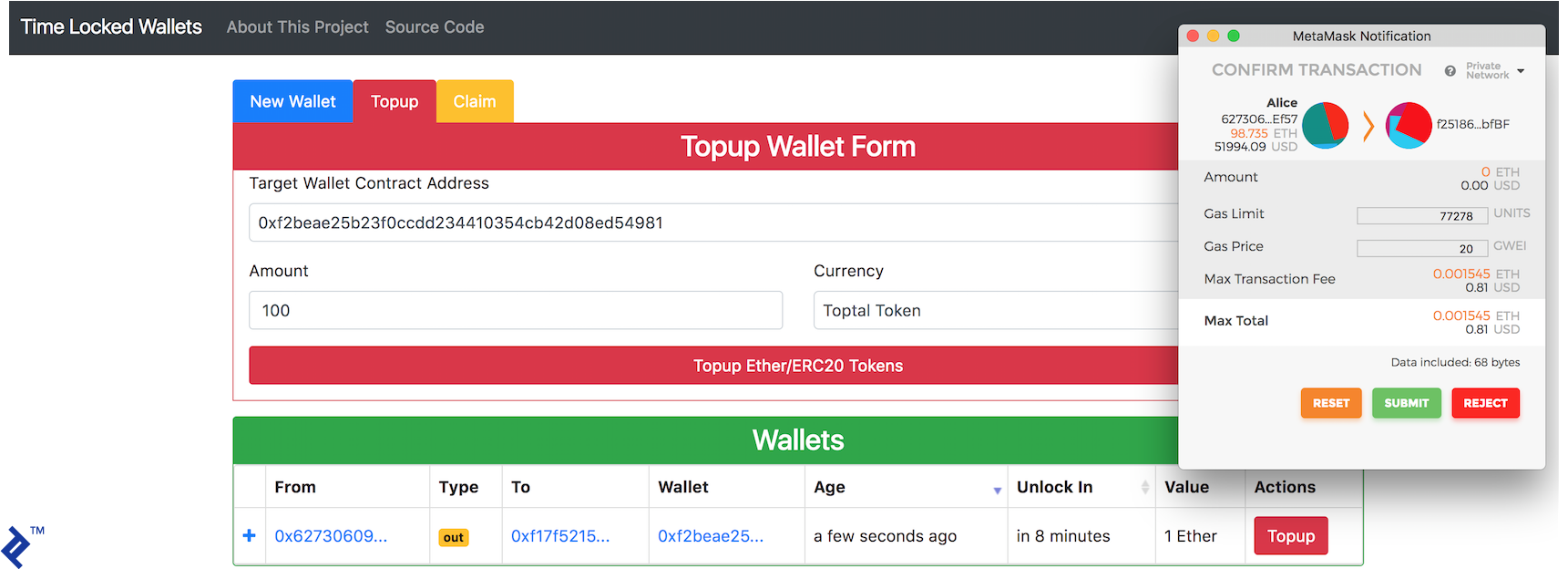
From Alice’s point of view, the wallet will look like this after the top-up:

Let’s switch roles now and log in as Bob. Bob should be able to see all the wallets he has created or is the recipient of. As the contract created by Alice is still time-locked, he cannot withdraw any funds:

Having patiently waited until the lock expired…

…Bob is now ready to withdraw both ether and Toptal Tokens:
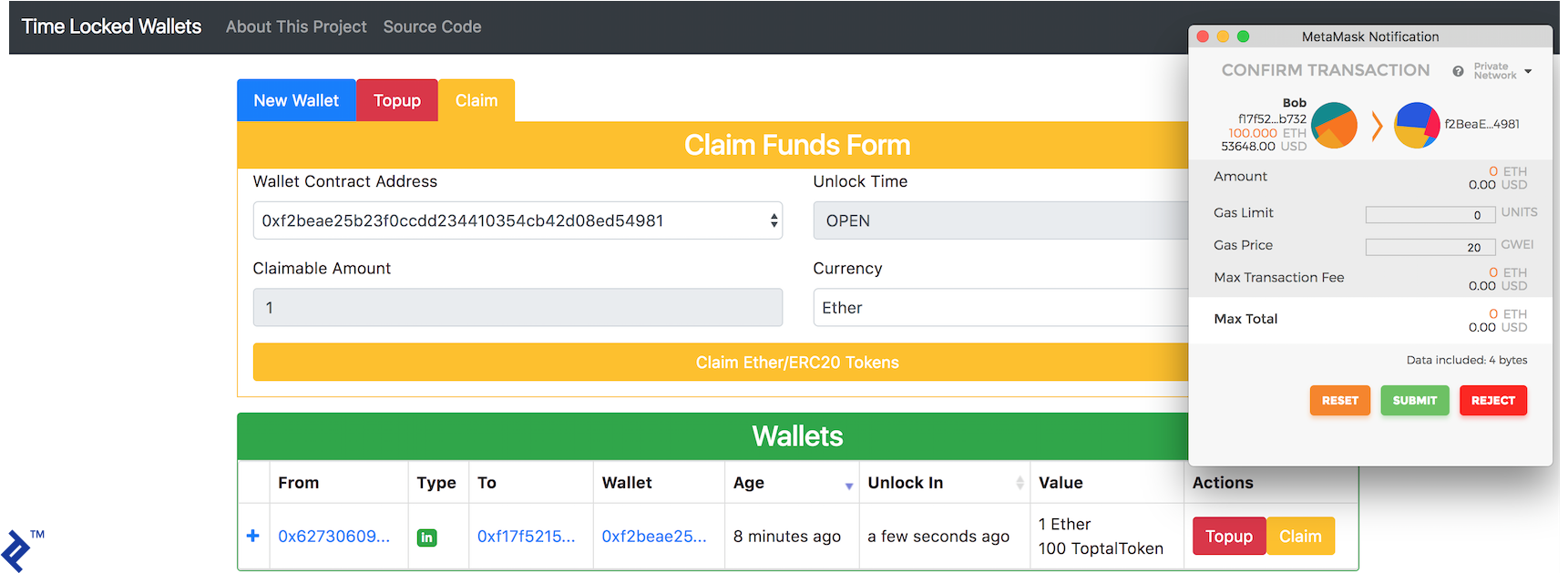

After emptying the time-locked wallet his address balance has increased and made him very happy and grateful to Alice:

Ethereum Network
If you want to interact with the described contracts, you don’t have to run them locally: We’ve deployed them to the Ethereum Rinkeby testnet. ToptalToken is deployed here and TimeLockedWalletFactory is deployed here.
You can use our deployed ÐApp, linked to the above contracts served by GitHub pages. Note that you need MetaMask installed and connected to Rinkeby.
Troubleshooting
We have come across a couple of issues while developing this project. The first one was the flakiness of MetaMask in Chrome (like complaining about invalid nonce). The easiest fix we found was to just to reinstall the plugin.
Also, Truffle would get out of sync sometimes when editing smart contracts and complain with an invalid number of solidity parameters error. We found that a simple rm -r build and doing a compile/migrate again would clear it.
Ethereum Development: Worth the Steep Learning Curve
We hope that this article has piqued your interest and that you will embark on your developer journey into the land of Ethereum. The path to cyber glory will be steep and time-consuming, but there are many resources out there to help you (like this one which helped us a fair bit). Feel free to get in touch via the comments below.
The source code for this project is available on GitHub.
If you would like to know how to use a uPort mobile app instead of MetaMask, have a look at the demo and source code of an alternative, hackathon-winning version of this project.
I also welcome you to read my follow-up tutorial, which focuses on ĐApp creation.
Credits
A big thanks goes to Maciek Zielinski for his contributions to this project.
Further Reading on the Toptal Blog:
Understanding the basics
What is a smart contract?
A smart contract is a computer code that gets executed on top of the Ethereum Virtual Machine. Smart contracts can send and accept ether and data. Contracts are immutable in nature, unless programmed otherwise.
What is the Ethereum Virtual Machine?
The Ethereum Virtual Machine (EVM) is a sandboxed runtime environment for smart contracts implemented as a stack machine that executes bytecode. It focuses on providing security and executing untrusted code by computers all over the world.
What are Mist and the Ethereum Wallet?
Mist is the official browser for distributed applications (ĐApps, sometimes dapps) which are user-friendly front-ends/UIs to the Ethereum network. Ethereum Wallet is one of these ĐApps. Both are developed by the same people that have built Ethereum.
Is Ethereum open source?
Quoting Vitalik Buterin, the inventor of Ethereum: “Everything at Ethereum, including the website, the tools, the whitepapers and of course all of the software and compilers are 100%, wall to wall open source and under the GPL.”
Is Ethereum decentralized?
Yes, it is fully decentralized in nature. Reading and writing operations are completely decentralized and currently secured by a proof-of-work mechanism. Ethereum is designed in such a way that no single person or group controls the blockchain.
What programming language does Ethereum use?
Ethereum’s language of choice is currently Solidity. Solidity is a contract-oriented programming language, mainly inspired by JavaScript, C++, and Python, used for writing smart contracts. There are other languages on the horizon, too, like Vyper.
What are ERC20 tokens?
Tokens are smart contracts implementing the ERC20 standard. They include operations like getting the total supply and balance and methods for transferring the tokens around. The tokens never really leave the contract, but are simply reassigned to a different holder’s wallet address in an internal mapping.
Radek Ostrowski
Phuket, Thailand
Member since September 24, 2014
About the author
Radek is a blockchain engineer with an interest in Ethereum smart contracts. He also has extensive experience in machine learning.
PREVIOUSLY AT

